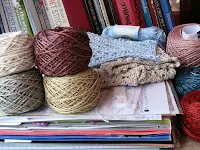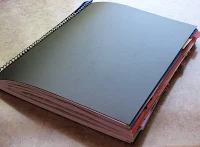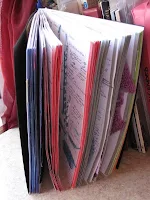 I wasn't aware of it myself until I designed the trapezoidal "Swingy Ruffles" bag for a Jean Leinhauser and Rita Weiss book in 2006. My first swatches resulted in rounded blobby shapes. No matter how dramatically I increased and decreased stitches in each row to create diagonal lines, the row edges restricted the shape.
I wasn't aware of it myself until I designed the trapezoidal "Swingy Ruffles" bag for a Jean Leinhauser and Rita Weiss book in 2006. My first swatches resulted in rounded blobby shapes. No matter how dramatically I increased and decreased stitches in each row to create diagonal lines, the row edges restricted the shape.As you can see in the photo above, the left and right edges of the yellow-green swatch are too tight, causing the top edge to bow outward. (These are Tunisian crochet swatches; see mini photo tutorial below.
 |
| Rosepuff Shawlette (regular crochet): a wide, shallow triangle. Its edge stitches need extra room to spread wide. |
Diagonal lines that are created by steadily increasing or decreasing stitches in every row need room to flex and breathe.
This is especially important for fashion crochet! Some elegant garments depend on the drape of truly angular edges for their dramatic flair.
Maybe you knew this already. If so, let me know if you've found advice like this in crochet books or sites because I like to alert crocheters to sources of great information.
Tunisian Crochet Edges
 |
| This became the Eilanner Shawl! |
The common squeeze-in-a-stitch method works okay except in cases where you are increasing a lot. That's the case with the swatches in the first photo: I increased at each end of every row.
Adding stitches repeatedly has a momentum to it, a vector. A small momentum can be absorbed by the stretch of the fabric, but a greater momentum needs room to fully expand. Shell stitches have this momentum too.
A way to look at it geometrically is that when we crochet a square with the same number of stitches in each row, the rows stack up in columns. Stitches fill their little slots. When we (more rarely) start in a corner and increase in each row for a while to make a triangle, and perhaps then turn it into a diamond by decreasing every row until it comes to a point, each added stitch at the edge is actually launching off on a diagonal angle.
How to Do It
 |
| From the Symmetrical Diamonds free pattern. |
- it has enough flexible drape for fashion designs
- it's substantial enough to support an added edging later
- the left edge and the right edge have equal tension and look equally nice to me (a tricky thing for Tunisian crochet!)
I recommend that you chain 1 first. It gives a more flexible edge, especially if you will be adding more increases to this edge in each row. It seems to control the tension of the first stitch. To my eye, the chain melts into the diagonal edge and adds a little substance.
 |
| Photo 1 of 3. |
If you add only 1 half-hitch, it's a flimsier loopy edge. I'm unable to find a video that would show you how to do a half-hitch while happily crocheting along, so until I create one I hope my 3 photos help. It's cool. I enjoy crocheting half-hitches. I like what they look like.
 |
| Photo 2 of 3. |
How to make a Half-Hitch: Your goal is to add a loop onto your hook that has a twist in it so that it stays on your hook. All I do is instead of doing a usual yarn over with the strand of yarn from the finger controlling the tension of the yarn, I yarn over with the strand behind my tension finger. I "scoop" it from the palm of my hand. I know, sounds weird, and a little video would clear it up instantly!
In photo 1 of 3, I added two loose half-hitches to the hook at the end of the forward pass. In photo 2 of 3 I simply tightened them. Aren't they cute?
 |
| Photo 3 of 3. |
How to crochet the return pass with the half-hitches: yarn over and pull through both half-hitch loops on hook (counts as 1 increase stitch worked off of hook), yarn over, pull through two loops on hook at a time until one loop remains on hook.
Tip: It might help you later to put a stitch marker in that pair of half hitch loops.
In photo 3 of 3 you can see what the two half-hitches look like now that I've pulled the yarn through them to begin the return pass.
What About the NEXT Row?
Crochet another forward pass of Tunisian simple stitch; start it with an increase like the row before. When you get to the end of this new forward pass, insert your hook in both end loops of the half-hitch pair. Then increase by making another pair of half-hitches.
When half-hitches are used to augment a widening left edge, you can see how they'll blend into the edge in a slightly bumpy, pretty way, and match the look of the chain 1 edge on the right edge.
Below I've added a quick edging.
 |
| I've added a simple edge: a quick slip stitch + chain 1 in each row end. |
























